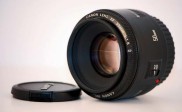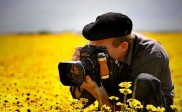A Beginner’s Guide to Cityscape photography
Cityscapes are just landscapes taken in an urban environment. So, basically, the same rules of landscape photography still apply with some more guidelines brought by the urban environment. Capturing cityscapes involves working on composition, light, point of view, perspective, etc., in order to capture the urban space in a spectacular way. Following are some guidelines and tips that may help you in your endeavor to capture that perfect cityscape.
Gear:
Well, basically all you need is a camera. It doesn’t matter whether it’s a point and shoot or a DSLR. You should work on getting the best results with whatever equipment you own. Of course, an ultra wide angle lens will help you in capturing a great skyline, and a telephoto lens will get faraway things to appear closer, but that shouldn’t be one of your preoccupations, you need to concentrate more on what really matters in this kind of photography, i.e. light, perspective and composition. And as Ernst Haas said “The camera doesn’t make a bit of difference. All of them can record what you are seeing. But, you have to SEE”.
That doesn’t mean that if you own advanced photo equipment, then you should leave it at home. It only, means that the technical side of photography shouldn’t take over the artistic side. You need to find a balance between the two sides, and it’s only then that you will achieve great cityscape photos.

Photo by Wvs
Preparation:
It goes without saying, that in order to be able to capture interesting cityscapes, you have to know your subject first. You can always take the explorer approach and wander aimlessly until you find something interesting, but that will only cost you your time and energy while you could have taken more interesting images in a shorter time. Whether it’s your city or a place you’ve never visited before, you should take the time to research it thoroughly to find out different factors that might help in capturing great cityscapes. Find out where famous buildings and interesting architectures are located, check the weather forecasts, to anticipate how the sky would appear in your photos, and look at other cityscapes by other photographers of that same place.
This research will help you to know what to expect and will provide you with a chance to find a new way to photograph the cityscape.
And don’t forget, being well prepared doesn’t mean you have to follow your plans at all costs. You still need to think out of the box and to break the rules sometimes. Being prepared will only make your chances at capturing an amazing shot bigger, when an unplanned thing happens.
Shooting Tips
So, you charged your camera’s batteries; you researched your destination very well; now you need to go out there and create amazing cityscapes. Here are some tips to help you.
-Shutter speed, aperture and ISO:
As with any other type of photography, the exposure triangle plays an important role in how your final result will look. When taking shots of Cityscapes, you will want your photos to be as sharp as possible, as clean as possible and with a depth of field as large as possible. Sharp photos can be achieved by using shutter speeds fast enough to avoid any camera shake that might occur. If you can’t set a fast shutter speed, consider using a tripod. For clean shots, and by clean I mean devoid of noise and grain, you should select the lowest ISO value possible. Finally, a large depth of field can be achieved through the use of small apertures and short focal lengths.
-The importance of light: Light and its quality play a crucial role in your image. Thus you need to pay close attention to the light and how the cityscape you intend to shoot changes under different lights. Midday light can be harsh and will make the colors look fade. When shooting cityscapes it’s better to choose a warmer and more beautiful light. I find that one of the best moments to shoot urban landscapes is around sunset and dusk. The tones of the sky and clouds are just beautiful and the warm sunlight offers different options. You can shoot with the sun at the side of your cityscape which will give nice consistent light to the different elements in your composition. You can also, use sunset light as a back light to create silhouettes with the buildings of a city. Another option is to wait till the last moments of dusk, when the sky has a tint of dark blue and the buildings are lit with artificial lighting. This combination of natural and artificial lighting can provide you with the most rewarding photographs.
– Composition and point of view:
When composing a cityscape, just like with a landscape, there are certain rules that will guarantee you, at least, descent results. Pay close attention to the lines in your photograph and make sure they appear the way they should. The horizon line needs to be perfectly straight, and also vertical lines of buildings need to be made as straight as possible. Use grid line present in most cameras in order to get all the lines straight at the shooting stage. Other types of lines are also important and may add a lot to a composition, such as converging lines and lines leading to an element within the composition.
When composing, try to only include what’s relevant to your composition and exclude any distracting elements from your frame. You can get rid of unwanted elements, by zooming in, moving a little bit to the left or to the right… The principle of less is more can be very true when composing a cityscape.
Finally, don’t just get to a spot and just press the shutter release from the position you are in. Work on finding an interesting point of view that will make the viewer more interested in the cityscape. Sometimes, you will need to shoot at ground level, and sometimes, finding an elevated spot is the key to succeed in capturing a scenery. Don’t limit yourself by shooting at eye level; make the extra effort and find that angle nobody thought of before. Your reward will be an image which will provide a fresh view of a well known scenery. To quote Ernst Haas again, “I am not interested in shooting new things – I am interested to see things new”
Here are some inspiring examples of cityscape photography:

Photo by Christolakis

Photo by Stuck in Customs

Photo by Stuck in Customs

Photo by ecstaticist

Photo by MikeBehnken

Photo by ecstaticist

Photo by andrew mace




Thanks for the tips, but most of the examples are eye burning HDR. Any examples that don’t make me want to visit the optometrist?
This is a great example: http://www.carbonangel.co.uk/imagedump/valenciaroof/DSC_4872.JPG
this is great! thanks a lot